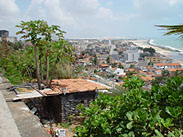Edible urban landscape
The Minimum Cost Housing Group (MCHG) of McGill and the International Development Research Centre are doing research that could map the city of the future.

Fruit-bearing tree planting in a barrio in Natal, Brazil (cashew bush in front, papaya tree in back)
Architecture professor Vikram Bhatt, director of MCHG, is leading the three-year project, called Making the Edible Landscape, which will look at urban agriculture.
According to the United Nations, half the world's population will be urban by 2007, a sharp rise from 1950 when 30 percent of Earth's denizens were city dwellers. By the year 2030, the urban population is expected to be five billion (of a projected 8 billion), and almost all the population increase until then will occur in urban areas of less developed regions.
To fight the shortfall of resources that are inevitable with this surge in urban living, people are turning to urban agriculture. This includes growing plants, medicinal and aromatic herbs, and fruit trees, and raising livestock, either for household use or to sell to neighbours.

A cow at the back of a home in Nairobi, Kenya
Bhatt says, "Designers and planners tend to create city landscapes for beauty, not utility. But many kinds of urban agriculture already exist around the world — from balcony gardens to poultry farms." City dweller and farmer needn't be mutually exclusive terms.
Some governments encourage and support urban farms and gardens, like in Havana, Cuba, where roughly 30 percent of available land is under cultivation. Others, such as those in sub-Saharan Africa, aren't supportive, even though urban agriculture helps poor people meet nutrition requirements in the face of economic crisis.
Montreal's own city-sponsored community gardens are an example of urban agriculture, but they aren't crucial to the well-being of Montrealers. In the overcrowded slums of developing-world cities, initiatives such as these, or new site plans or housing designs, can make a huge difference to the quality of life.
The challenge is to view lettuce and chard on equal footing with bricks and mortar. Urban planners and architects first think of housing, parking and commercial development when they design cities, but they should consider the benefits — social, visual and physical — of producing food on urban land. City farming, no matter how small in scale, contributes to food security and energy conservation, and a sense of community. People can glean satisfaction and pleasure from making fertile use of roadside patches of land and abandoned lots, as well as save money.

Duck farming in an urban setting
Three partner cities from different continents were chosen for the project: Colombo, Sri Lanka; Kampala, Uganda; and Rosario, Argentina. By collaborating with local researchers, architects and community leaders, the group will test the potential of urban agriculture in meeting the UN Millennium Development Goals, which include squatter settlement upgrading, poverty alleviation, food security and gender equity.
The urban designers involved in the project can incorporate agricultural activities in development plans of houses and neighbourhoods, and draw on support and information networks offered by the project. If urbain agriculture is done safely and thoughtfully, it can be a terrific feature of sustainable city growth. "What we learn from these test sites will enrich cityscapes of the future, both north and south," says Bhatt.
Co-researchers of Making the Edible Landscape include David Brown, Director of the School of Urban Planning; architecture graduate student Rune Kongshaug; Jeanne Wolfe, of the School of Urban Planning; John Henning, chair of the Department of Agricultural Economics at Macdonald Campus; and UN-HABITAT's Marielle Dubbling.
The group will present their findings at the 2006 UN-HABITAT's World Urban Forum in Vancouver. For further information, go to www.unhabitat.org/wuf/2004, www.idrc.ca/wuf and www.mchg.mcgill.ca.
